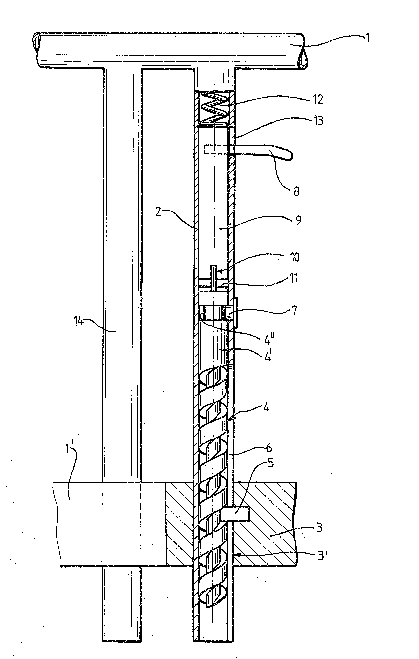Une partie des informations de ce site Web a été fournie par des sources externes. Le gouvernement du Canada n'assume aucune responsabilité concernant la précision, l'actualité ou la fiabilité des informations fournies par les sources externes. Les utilisateurs qui désirent employer cette information devraient consulter directement la source des informations. Le contenu fourni par les sources externes n'est pas assujetti aux exigences sur les langues officielles, la protection des renseignements personnels et l'accessibilité.
L'apparition de différences dans le texte et l'image des Revendications et de l'Abrégé dépend du moment auquel le document est publié. Les textes des Revendications et de l'Abrégé sont affichés :
| (12) Brevet: | (11) CA 1305400 |
|---|---|
| (21) Numéro de la demande: | 1305400 |
| (54) Titre français: | DISPOSITIF DE REGLAGE VERTICAL DES APPUI-BRAS D'UN FAUTEUIL, EN PARTICULIER D'UN FAUTEUIL ROULANT |
| (54) Titre anglais: | DEVICE FOR VERTICAL ADJUSTMENT OF ARM SUPPORTS ON CHAIRS, ESPECIALLY WHEEL CHAIRS |
| Statut: | Périmé et au-delà du délai pour l’annulation |
| (51) Classification internationale des brevets (CIB): |
|
|---|---|
| (72) Inventeurs : |
|
| (73) Titulaires : |
|
| (71) Demandeurs : | |
| (74) Agent: | SMART & BIGGAR LP |
| (74) Co-agent: | |
| (45) Délivré: | 1992-07-21 |
| (22) Date de dépôt: | 1989-06-12 |
| Licence disponible: | S.O. |
| Cédé au domaine public: | S.O. |
| (25) Langue des documents déposés: | Anglais |
| Traité de coopération en matière de brevets (PCT): | Non |
|---|
| (30) Données de priorité de la demande: | |||||||||
|---|---|---|---|---|---|---|---|---|---|
|
A b s t r a c t
In a device for vertical adjustment of arm supports on
chairs, especially wheel chairs, each arm support (1) is
carried by a support pipe (2) longitudinally displaceably
arranged in a bore (3') of a part (3) rigidly connected to
the chair frame (1'), the support pipe (2) being lockable to
the chair frame (1',3) in its various positions of
longitudinal displacement. It is aimed at providing a device
of this kind wherein the height adjustment of the arm
support occurs infinitely variably and controlled, and
wherein the height-adjusting device is handy in use. For
this purpose a longitudinally non-displaceable motion screw
is rotationally supported within the support pipe (2), a lug
(5) rigidly connected to the chair frame (1',3) engaging
said motion screw, the latter being adapted to cooperate
with a manually releasable (8) locking device (9, 10) which
in the locking position prevents rotation of the motion
screw (4).
(Figure 1)
Note : Les revendications sont présentées dans la langue officielle dans laquelle elles ont été soumises.
Note : Les descriptions sont présentées dans la langue officielle dans laquelle elles ont été soumises.

2024-08-01 : Dans le cadre de la transition vers les Brevets de nouvelle génération (BNG), la base de données sur les brevets canadiens (BDBC) contient désormais un Historique d'événement plus détaillé, qui reproduit le Journal des événements de notre nouvelle solution interne.
Veuillez noter que les événements débutant par « Inactive : » se réfèrent à des événements qui ne sont plus utilisés dans notre nouvelle solution interne.
Pour une meilleure compréhension de l'état de la demande ou brevet qui figure sur cette page, la rubrique Mise en garde , et les descriptions de Brevet , Historique d'événement , Taxes périodiques et Historique des paiements devraient être consultées.
| Description | Date |
|---|---|
| Inactive : Demande ad hoc documentée | 1996-07-21 |
| Le délai pour l'annulation est expiré | 1996-01-22 |
| Lettre envoyée | 1995-07-21 |
| Accordé par délivrance | 1992-07-21 |
Il n'y a pas d'historique d'abandonnement
Les titulaires actuels et antérieures au dossier sont affichés en ordre alphabétique.
| Titulaires actuels au dossier |
|---|
| ARNFINN FROYLAND |
| THORBJORN LOHRE |
| Titulaires antérieures au dossier |
|---|
| S.O. |